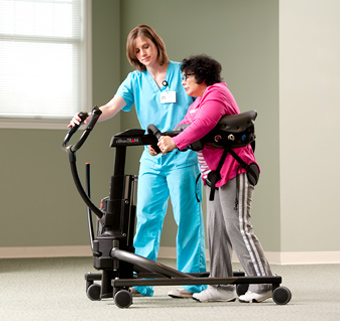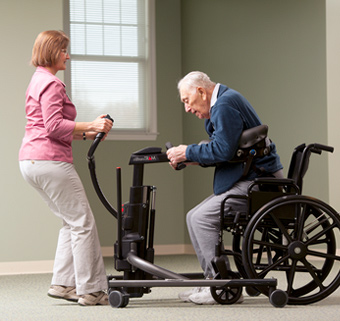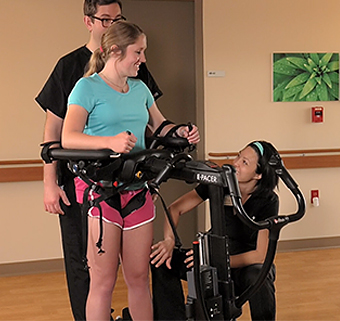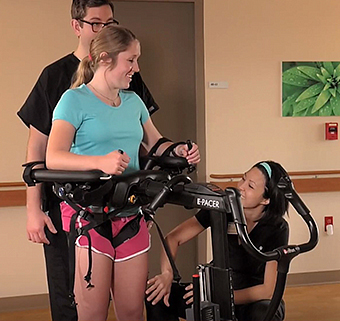Improved Rehab Intervention with the TRAM
| May 2015The Rifton TRAM is a great addition to our skilled rehabilitation department, especially for those patients with neurological deficits. One therapist can safely assist a patient in the TRAM through a functional mobility progression starting with sitting balance on the edge of the bed, standing tolerance, posture and then gait normalization. In the past, many of these therapeutic activities needed multiple therapists coordinating their schedules and abilities for co-treatments. I consider the TRAM a second pair of therapeutic hands giving me the freedom to work one-on-one with my patient without the fear of falls or injury. Let me give an example.
Michelle (not her real name) came to us after experiencing a stroke resulting in weakness and neglect on her left side. We started treatment without a TRAM. It took two or three therapists to get her in an upright sitting position on the edge of the bed. In this position she needed maximum assistance to keep from falling backwards. So the therapist was unable to interact with Michelle in other therapeutic activities to practice sitting balance, one of the core activities for rehabilitation progression. Eventually, Michelle started to practice standing in the parallel bars, again with the assistance of two or three therapists. A session in the parallel bars lasted as long as the therapists’ strength held out.
 Then we got the Rifton TRAM and the benefits were immediate and manifold. When we placed Michelle in this device, she sat on the edge of the bed with her body positioned upright by the TRAM’s trunk support. She was safe and could begin to “feel” how the center of her body should be aligned in space. Her therapist could work on upper extremity movements that challenged Michelle’s sitting balance. As Michelle began to progress, her therapist added a pelvic harness to the TRAM which is used to assist a patient into the standing position. This is made possible with a battery-powered telescoping lift column. In standing, Michelle began to practice correct posture, head turning, foot placement and weight-bearing. She felt secure in the TRAM and standing sessions lasted longer, ending only when Michelle’s endurance ran out.
Then we got the Rifton TRAM and the benefits were immediate and manifold. When we placed Michelle in this device, she sat on the edge of the bed with her body positioned upright by the TRAM’s trunk support. She was safe and could begin to “feel” how the center of her body should be aligned in space. Her therapist could work on upper extremity movements that challenged Michelle’s sitting balance. As Michelle began to progress, her therapist added a pelvic harness to the TRAM which is used to assist a patient into the standing position. This is made possible with a battery-powered telescoping lift column. In standing, Michelle began to practice correct posture, head turning, foot placement and weight-bearing. She felt secure in the TRAM and standing sessions lasted longer, ending only when Michelle’s endurance ran out.
Currently, Michelle uses the TRAM for gait training, particularly forward propulsion, foot placement and steering. With Michelle safe in the TRAM, her therapist works on manually correcting her scissor gait pattern. Working in the TRAM also makes it possible for Michelle to walk without a knee immobilizer or an ankle foot orthosis. After just one session in the device, Michelle walked 160 feet with minimal assistance. (I like to contrast that to five feet in the parallel bars with maximal assistance from two therapists to hold Michelle in an upright position, support the left arm, block the left knee and keep her trunk from flexing forward!)
And Michelle is only one patient. Overall, the TRAM has enabled our rehab team to provide better strategies for the best rehabilitation outcomes for many of our patients. It has become an essential element of our rehab service delivery.




